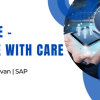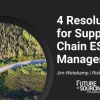An unlikely health and safety pandemic has thrown the world into a tailspin. Regulatory changes related to COVID-19 are already touching all facets of the industry. They are likely to continue to evolve at a brisk pace, making it difficult for some employers to keep up. Although it would have been impossible for any company to be fully prepared for such low probability, the companies that put health and safety at the forefront of their efforts have found themselves in a much better position to respond. Companies that came into this crisis already behind the curve are struggling to keep up and will ultimately need to reprioritize health, safety, and business continuity plans moving forward.
Compliance for Compliance’s Sake
The COVID-19 crisis has opened an entirely new chapter in risk management, one that has tested the strength of many companies’ resiliency and their ability to model a new kind of risk management plan. It’s unlikely that very many businesses had emergency response plans that envisioned this type of massive-scale infectious virus.
Every organization has some level of business continuity planning and compliance around known and probable risks – including natural disasters, local emergencies, shutdowns, security breaches, and fires. Some businesses may have included a limited number of actions around pandemics, especially if their operations were impacted in such previous outbreaks, such as SARS in 2014. But many of these plans were only routine “check-the-box” efforts, where compliance with the checklist was the main goal. When the unprecedented upheaval of COVID-19 hit, organizations everywhere had the same questions:
- What should we do?
- What can we do?
- What can’t we do?
- What is legal, what is not?
- What aren’t we thinking of?
Unfortunately, perfunctory risk plans left many of those questions unanswered. Without robust and genuine programs around known and probable risks, some organizations found themselves largely unprepared for this historic event. Without a strong core of risk, health, and safety response programs, many companies were unsure of how to approach COVID-19. In the early going, this paralysis proved costly.
Now, these companies must scramble to answer more pointed questions in order to move forward effectively:
- If worker safety wasn’t already a priority, how will you quickly move to address new health risks?
- If you didn’t already have a strong framework to assess and address risk, how are you going to prioritize resources?
- If your Environment, Health, and Safety (EH&S) program is in its own silo, how are you going to quickly address new labor laws, new life safety requirements, new EPA regulations, new CDC recommendations, and new facility layout and occupancy guidelines?
- How will you wind down facilities to operate with skeleton crews if there is not already an established and rehearsed process?
- If your EH&S or emergency action plans were not strong, how will you layer in new infection control requirements?
For a company with a weak foundation, it will be extremely difficult to scale up and manage this incredible new risk and implement associated regulations. If there will be a silver lining from COVID-19, it could be the end of compliance for compliance’s sake, in favor of moving toward an enterprise-wide risk management approach across businesses.
Health and Safety as Foundational to Company Culture
Ask any CEO or senior leader to cite their key priorities, and you will get a wide range of responses. The logistics leaders who were best prepared for COVID-19 place health and safety near the top of their list and did so before the pandemic crisis. Key leaders in these companies set a very clear philosophical or ideological tone that health and safety are foundational to the business. They intentionally align workforce health and safety goals with customer and financial goals across the enterprise.
These companies don’t just comply with requirements – their focus is on the intent behind those requirements. These health-and-safety-focused organizations have very clear and effective procedures that are constantly improved, funded, and resourced with transparency around performance. Ultimately this cultivates a strong health and safety mindset at the core of its operations—its employees.
There is nothing perfunctory about the health, safety, and continuity plans of a business where health and safety is a top organizational priority. Certain companies came into the crisis with well-developed programs that could be modified to layer in quickly evolving requirements to protect employees, customers, and critical supply chains. Their business continuity plans were not sitting in a drawer with outdated phone numbers and addresses; they were living documents, developed and driven through cross-functional teams with representation from operations, facilities, human resources, risk management, quality, and finance or procurement to ensure balance and buy-in. Successful companies also anticipated how risks and plans impacted customers and critical supply chains and had the ability to address an emerging risk like COVID-19 quickly.
Trish St. John, VP of Safety and Quality Assurance at Suddath®, said her team has been working since the start of the pandemic to implement changes quickly and efficiently. However, there are still a lot of unknown variables.
“We don’t have all the facts, there’s still a lot unknown, but leaders and health and safety professionals should be making the best informed decisions with what we do know using data, predictive analytics and a myriad of policy and regulatory changes to make quick decisions focused on mitigating risk,” St. John said. “Because Suddath had such a robust safety and quality program prior to this, it’s been easier to meet new regulatory and customer requirements to make sure we do our part to enable them to operate effectively through the pandemic.”
Prepared organizations not only developed comprehensive plans, but they maintained coordinated plans that were site-specific with rigor around training and rehearsal. These companies were also in a better position to envision the steps needed to solve new challenges rather than starting from scratch. With a mature good hygiene practices (GHP) program, hand hygiene, wellness, and sanitation guidelines can be broadened to other locations. If a company has a sophisticated life safety program, employees can better adapt to new egress and occupancy rules. If a company’s EPA and hazardous waste programs are up to date, it will be easier to keep pace with changing regulations. The companies that embrace health and safety within their core philosophies are in a much better position to weather the storm and use any crisis to ultimately strengthen their business model.
Triple-Bottom-Line Thinking in Third-Party Logistics
Companies and society have broadened our definition of the bottom line. Making money remains the objective of any commercial operation, but the impact we make on our employees, our communities, and our environment is critical to holistic success. Leading third-party logistics companies did not need a health pandemic to refocus on employee safety – they were already doing the right things to protect worker safety, an approach that can readily be adapted to mitigate new risks.
|
Perfunctory Plans |
Genuine Plans |
|
Generic |
Focus on the intent of the requirement |
|
Focus on meeting a requirement |
Ask what we should do |
|
Ask what must we do |
Adaptable, continually improving - the goal is continuous improvement |
|
On a shelf or in a drawer |
Site, region or customer-specific |
|
One size fits all |
Easy to layer in new requirements |
|
Difficult to adapt to a changing environment |
Developed by cross-functional teams |
|
Developed without structured collaboration |
Specific response teams |
|
Undefined response teams |
Customized to your business, anticipating customer impact |
|
|
Ready for use now |









